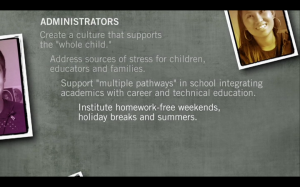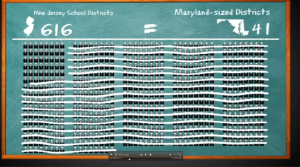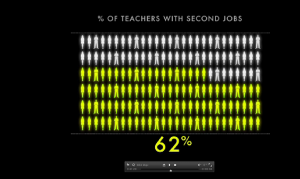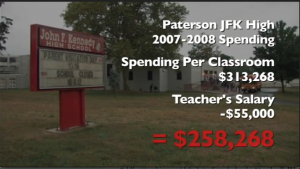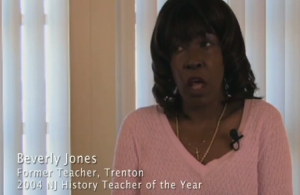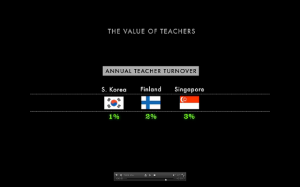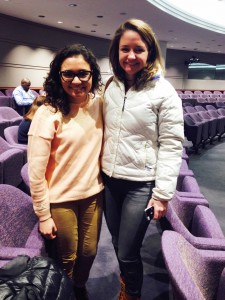When an Alabama Education Administrator, Tony Thacker, spoke on behalf of the significance of teachers, he said adamantly, “there are two sets of adults: classroom teachers who ensure the future of our students, and everyone else” (00:3:17). The 2011 documentary, American Teacher, strives to validate his notion of teaching as an important and powerful profession and destroy the stereotype that the job of a teacher is trivial and undemanding. Teachers provide the knowledge and skills necessary to empower children, but their role in the classroom and in the lives of students has been historically belittled. Unfair policies pay teachers little and provide them with few benefits; likewise, social misunderstandings of teaching devalue the profession. Thus, teachers go underpaid and unappreciated. With complaints of low salaries, lack of prestige, and long hours, it is no wonder why highly skilled people rarely become teachers, and why many others quit teaching. American Teacher, directed by Vanessa Roth and Brian McGinn, looks to eliminate preconceived notions of teaching by combining the diverse experiences of American public school teachers, with illustrations of the problems in education policy by leaders in education reform. In doing so, the documentary sheds light on the difficulties and injustices found in a profession immensely responsible for individual and nationally success.
Research has proven that teachers are the most significant in-school factor in providing students with the ability to succeed. Education historians like Diane Ravitch, billionaire philanthropists such as Bill Gates, and political leaders like President Barrack Obama, have conceded that a teacher’s role in academia is vital. If this is true, why are few top college graduates pursuing teaching, and why do hundreds of teachers leave the classroom after only a few years? (00:03:03). American society undermines the important role that teachers play in the lives of students, and this directly explains the lack of cultural respect for teaching as well as their poor salary rates. These injustices in the workforce prompted the creation of The Teacher Salary Project, a non-profit organization that advocates for improving teacher conditions, such as creating competitive salaries. The project is comprised of national campaigns, an online resource site, and the documentary, American Teacher. Their website states: “The film’s narrative balances the personal stories of each character with a mixture of interviews and animated facts and statistics by Stefan Nadelman, each highlighting the big sacrifices made by our nation’s teachers, and how these demanding costs force many of our greatest teachers out of the profession” (About the Project). The Teacher Salary Project aspires to make teaching a respected and desired career path by instilling excitement in the career and promoting financial sustainability. American Teacher has been reviewed by newspapers like The LA Times which characterized the documentary as “unsettling” (Turan 1), and The New York Times, which called it “heartfelt”, but criticized it for treating “pay as if it’s the only factor in educational dysfunction” and assuming “teaching is the most vital of the undercompensated jobs” (Genzlinger 1) Regardless of The New York Times critique, I believe American Teacher brings to life two important realities in the education system: we cannot expect success in classrooms if our teachers lack the financial ability to provide it and the cultural respect they need to ensure it.
American Teacher embraces the stories of teachers like Jamie Fiddler, Amanda Lueck, Erik Benner, Rhena Jasey and Jonathon Dearmon who endeavor to provide their students with the best means to succeed in an environment that offers them little to no assistance or compensation. For a profession capable with impacting the future of so many, the circumstances of such teachers have never been more unacceptable. Their paychecks, unions, credentials, and teaching styles have long been criticized. Misnomers have blinded policymakers and political leaders from being able to make the profession of a teacher both reputable and obtainable. American Teacher aims to finally clarify what it means to teach.
Senior V.P. of Fox News Channel, Neil Cavuto, claims teachers’ desire for
higher salaries and better conditions is out of self-interest.
To begin, inefficiency is common in the public school system; many lack the proper resources for teachers and students, inevitably putting teachers in unfair positions. One teacher, Jamie Fiddler, of Brooklyn, New York, is victim to many of these financial burdens that go unrecognized. In her first year of teaching, Fiddler spent over $3,000 dollars of her own money on essential school supplies, and she isn’t alone. A shocking 90% of public school teachers pay for materials like markers and books out of their own pocket (00:07:11). Another teacher, Amanda Luek of Horace Mann Middle School in Denver, Colorado, describes the job of a teacher as a tiring lifestyle. There are constantly lesson plans to be made, homework to be graded, and classrooms to be reorganized. Luek’s classroom is too small for the number of students she has; consequently, some of her students have to sit on the counters. “There’s always more to do” says Luek, after another eleven hour work-day, and “it never feels like enough” (00:8:47). These two examples opened my eyes to aspects of teaching that go unnoticed and that are masked by politicians and policymakers who claim teaching is an easy and unimportant profession. Rather, teachers are responsible for more than they are given credit for. They do so much voluntarily simply to provide the bare minimum for their students.
View of Teacher Amanda Luek’s small classroom for her 40 students.

The financial demands of teaching are highly consequential in the long run. Erik Benner, a former history teacher and athletic coach at a Texas public school, was a popular teacher among students and faculty for his strong commitment to teaching and personable character. Benner, who instilled in his students a sense of commitment to learning, was dedicated to building a strong rapport with each student he taught. Nevertheless, with a teaching salary of $27,000, Benner was obligated to pick up a second job at a hardware store – a stress-inducing decision that lessened his time with his family and students (00:37:13). Eventually, when he was laid off from his second job, he was forced to quit teaching. His lack of sustainable income caused his house to go in foreclosure and years of financial tensions prompted a split in his marriage. Approximately 31%-62% of teachers must take on a second job. The low level of teacher salaries simply leave many with no other choice (00:41:09).

Teacher, Erik Benner, working his second job at Circuit City
While the lack of respectable salary deters many from beginning or continuing to teach, the absence of prestige in the profession also suggests a shortage in the quality of teachers. Rhena Jasey, a Harvard graduate and former New Jersey school teacher, is one of the few top-college graduates to become a teacher. When she told her friends she wanted to teach, she paraphrased their replies in saying: “Anyone can teach. You went to Harvard. You should be a doctor or a lawyer. You should make money” (00:17:56). For her, teaching provides a dynamic, comprehensive role in the lives of students. Teachers constantly make decisions for their students that go far beyond the role of teaching. Thus, the complexity in the role of a teacher is significantly more challenging than it is portrayed to be. Jasey believes a teacher is simultaneously a counselor, parent, friend, and social worker. These many roles, however, go unrewarded, and Jasey’s former $40,000 salary showed it. No one would question the salary level for another profession, but because many do not believe a high skill set is necessary to be a teacher, few believe the state of teacher salaries is an issue. This, in itself, is alarming. If many talented, top-college graduates do not see teaching as a sustainable career because the profession lacks a strong reputation in relation to other degrees, whilst providing poor salaries, American students will continue to pale in comparison to the students in other countries and will not be able to fully meet their highest potential. Similarly, if our nation does not recognize that a high skill set is necessary in teaching, many will not see the hidden injustices in teacher salaries. The inability to attract bright graduates to the teaching profession is frightening. Without quality teachers, how can we expect quality students? Rhena’s credentials and character embody what the teaching workforce needs. “You don’t want your kids being taught by someone who went to Harvard?” she’d tell her family and friends (00:18:27). The social belief that bright professionals should not become teachers directly relates to why student achievement in America is low.

Teacher Rhena Jasey discusses the reputation of teaching
The reputation associated with teaching significantly decreases teacher quality and thus, student learning. There are far too many teachers unable to make ends meet, who work hours far above the presumed six hour work-day, that lack both financial and reputational compensation for all they do. Just as well, there are teachers, fatigued and frustrated, unwilling to continue in a profession that desperately needs talented people. Statistically, 20% of teachers in urban environments leave teaching every year, and 46% quit before their fifth year of teaching (00:47:36). The use of statistics like these in the documentary made it apparent how crucial it is that we re-examine the treatment of our teachers. This data provides a caveat to policymakers and reformers everywhere. When strong teachers leave the profession, children everywhere are negatively affected: an unacceptable and dismaying truth.
When teacher Jonathon Dearmon left the profession due to financial reasons, his students filled his chalkboard with notes to express their appreciation for him.
A 2011 study by the Hoover Institution indicates that an effective teacher has the capacity to give a year and half of learning in one year, demonstrating that the quality of the teacher can either drive up achievement levels or negatively impact the success of students. Hanushek states this by relating student achievement to the labor market: “For the average American entering the labor force, the value of lifetime earnings for full-time work is currently $1.16 million. Thus, an increase in the level of achievement in high school of a standard deviation yields an average increase of between $110,000 and $230,000 in lifetime earnings” (Hanushek 2). The standard deviation illustrates the amount of deviation that exists from the average. Similarly, Hanushek’s studies present a correlation between national economic success and effective teachers. They recognize that an effective teacher can drive up student achievement, improving American students as a whole and increasing the gross national product. However, if policymakers fail to recognize these very real correlations, the important variable of the teacher will never be truly acknowledged.
Some institutions have realized the importance of recruiting and maintaining quality teachers into the profession. Projects like The Equity Project Charter School, or TEP, pioneered by Zeke Vanderhoek, have started to change the perceptions of teaching by endeavoring to treat teachers with the respect and prestige they deserve. TEP starts teachers at a base salary of $125,000, made possible through public funds. One of the teachers hired was Harvard alum, Rhena Jasey. TEP’s website articulates their philosophy: “student achievement is maximized when teachers have the time and support to constantly improve their craft” (Philosophy). While many factors are comprised in evaluating student achievement, improving the standards and conditions for teachers substantially improves student performance.
 Data proves that the countries with top performing schools and education programs, Finland, Singapore, and South Korea, also hold teaching to a high esteem.
Data proves that the countries with top performing schools and education programs, Finland, Singapore, and South Korea, also hold teaching to a high esteem.
Still, there is much to be done to reform teaching today. When discussing the unacceptable circumstances teachers encounter, Mark Bounds, the Deputy Superintendent for Educator Quality in South Carolina shares: “They’re not asking to make hundreds of thousands of dollars. They’re asking to be able to buy a house, to have a descent car, to live in a nice neighborhood, to have some comforts” (00:52:40). Ultimately, the battles that teachers face are not only policy problems, but also, social problems. The countries in the world with top-performing students and academic programs, Finland, Singapore, and South Korea, not only have funded teacher training, competitive salaries, and professional working environments, but they also culturally respect the role of a teacher – an occupation that outweighs the reputation of lawyers and doctors (01:06:02). If we are to see the true value of teachers, we must increase the incentives to teach, raising it to the same standards of other professions and socially recognizing that the job of a teacher is monumentally important in defining our nation.
In Chapter Seven of her book, The Death and Life of the Great American School System, titled “What Would Mrs. Ratliff Do?”, historian Diane Ravitch speaks of the problems teachers have faced for years. Many have criticized their tenure, unions, and methods that go beyond teaching to the test. Rather, Ravitch defends teachers in saying that union contracts and tenure protect the rights of teachers, ensuring that their salaries are based off their credentials and seniority, not the results of student tests (Ravitch 171). Ravitch reminisces about her high school teacher, Mrs. Ratliff, who instilled in her students a passion for literature and learning. Mrs. Ratliff was demanding, caring, and did not teach based on a test. Great teachers like Mrs. Ratliff are lacking today in our society because the career lacks incentives, like reputable salaries and because teachers are being forced to teach to the test. Therefore, our society must make a decision. Ravitch ponders this policy and social dilemma in stating, “as we expand the rewards and compensation for teachers who boost scores in basic skills, will we honor those teachers who awaken in their students a passionate interest….? If we fail to attract and retain teachers like Ruby Ratliff, will we produce a better-educated citizenry” (Ravitch 194)? It is in how policymakers and society answer these questions that will change the face of American education.
In the end, we must be aware that the effort needed to change teacher conditions concerns us all and that the lack of carrots for teachers is a true problem. To paraphrase Sabrina Laine, the Vice President for Educator Quality at the American Institute for Research, there are many benevolent aspects ingrained in teaching, but that does not justify their low salaries. Teaching isn’t about money, but that doesn’t mean teachers should be poorly paid (00:35:40). As the two film producers for American Teacher, Eggers and Calegari, declared in their New York Times Op-ed piece: “When we don’t get the results we want in our military endeavors, we don’t blame the soldiers. We don’t say, ‘It’s these lazy soldiers and their bloated benefit plans! That’s why we haven’t done better in Afghanistan!’ No, if the results aren’t there we blame the planners…. No one contemplates blaming the men and women fighting every day in the trenches for little pay and scant recognition” (Eggers, Calegari 1). The same goes for teachers. If we expect American students to succeed, we must open our eyes to the way we are treating their educators. Only then, will we better improve the lives of school children and America altogether.
 The low salaries and reduced conditions of teachers are directly correlated to decrease in student achievement in American schools
The low salaries and reduced conditions of teachers are directly correlated to decrease in student achievement in American schools
Works Cited:
“About the Project .” Teacher Salary Project. N.p., n.d. Web. 21 Feb 2014. .
American Teacher. Dir. Vanessa Roth, Brian McGinn. Prod. Ninive Calegari and Dave Eggers. Perf. Erik Benner, Neil Cavuto, Matt Damon. 2011. Documentary.
Eggers, Dave, and Nínive Clements Calegari. “The High Cost of Low Teacher Salaries.” The New York Times. The New York Times, 30 Apr. 2011. Web. 22 Feb. 2014.
Genzlinger, Neil. “What’s a Teacher Worth?” The New York Times. The New York Times, 29 Sept. 2011. Web. 23 Feb. 2014.
Hanushek, Eric A. “Valuing Teachers: How Much Is a Good Teacher Worth?” Hoover Institution: Stanford University. Education Next, 2011. Web. 04 Mar. 2014.
“Philosophy.” TEP Charter – Philosophy. N.p., n.d. Web. 23 Feb. 2014.
Ravitch, Diane. The Death and Life of the Great American School System: How Testing and Choice are Undermining Education. New York: Basic, 2010. Print.
Turan, Kenneth. “What the ‘American Teacher’ Has to Teach Us.” Los Angeles Times. Los Angeles Times, 30 Sept. 2011. Web. 23 Feb. 2014.

